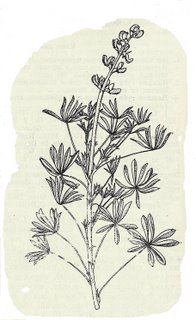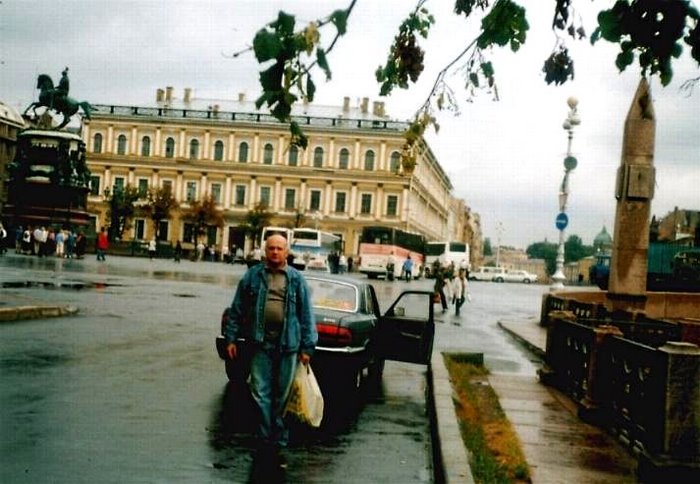 L. luteus
L. luteus L. 1753, Sp. Pl. :722; Willd. 1803, l. c.:1024; DC. 1825, l.c.:407; Willk. et Lange, 1880, l. c.:468; Franco et Silva, 1968, l. c.:105; Zohary, 1972, l. c.:44; Gladstones, 1974, l. c.:17; Vass. 1987, l. c.:214. –
yellow lupin.
Typus: Herb. Linn. No 898-8 (LINN).
Protologus: « In Siciliae arenosis ».
Figure -
Lupinus luteus L. (holotype).
Plants are 20-80 cm high, rosetted in the beginning and becoming erect in subsequent, with vigorous basal branching. Stems are short and hirsute, with intesive branching in the lower part. The leaf consists of 7-9 (11) ovate-oblong or lanceolate leaflets, prolated at the basis, densely villous on both sides, sized 30-60 х 8-15 mm. Stipules of the rosetted leaves are crescent and chuffy on stalks, linear-obovate in shape. The inflorescence is an elongated truss, 5-25 cm long, set on a peduncle of 5-12 cm. Flowers are verticillate, odorous. Floral bracts are small-sized, obovate, silky-pubescent, easily falling. The upper labium of a calyx is bipartite, the lower one has 3 small denticles. The corolla is 14-16 mm long, bright goldish-yellow in color. Pods are elongated, 40-60 х 10-14 mm, densely villous, 4-6-seeded, with oblique partitions between seeds. Seeds are 5,5-6,5 mm in diameter, spherical-reniform, oblate, variable colouring - from pinkish, brown and yellowish up to dark-violet and mottled.
2n=52 .
Occurs on mild sandy and volcanic soils in mining belts. As a wild plant, it is widespread over the coastal area in the western part of Iberian Peninsula, Morocco, Tunisia, and Algeria, on the islands of Corsica, Sardinia and Sicily and in southern Italy. In Israel and Lebanon it has most likely turned wild. It is cultivated in Northern Europe and CIS (Belarus and Ukraine) as well as, on a smaller scale, in Western Australia and South Africa. Having previously been cultivated in southern France and on Madeira, it has turned wild there.
Usually this species is considered as an annual one, but in wild environments it is sometimes possible to find two- and four-year plants. The variability of characters in this species is less expressed than in
L.angustifolius; however a homologous series can be modeled on the color of seeds, which is more or less similar to
L. angustifolius. Dominating coloring of flowers is yellow or, less frequently, lemon-yellow, orange and whitish.
Using combinations of such characters as the color of the corolla, the carina`s edge, vegetative organs and seeds, 18 varieties, 4 subvarieties and 6 forms have been identified.
The scheme of classification of
Lupinus luteus L.
I. Var.
luteusI. f.
volovnenkoae Kurl. et Stankev.
2. f.
compactus Kazim. et Kaz.
2. Var.
maculosus Kurl. et Stankev.
3. Var.
kazimierskii Kurl. et Stankev.
4. Var.
arcellus Kurl. et Stankev.
5. Var.
sempolovskii (Atab.) Kurl. et Stankev.
6. Var.
melanospermus Kurl. et Stankev.
7. Var.
niger Kurl. et Stankev.
8. Var.
cremeus Kurl. et Stankev.
9. Var.
leucospermus Kurl. et Stankev.
I. Subvar.
leucospermus3. f.
ucrainicus Kurl. et Stankev.
2. Subvar.
taranuchoi Kurl. et Stankev.
10. Var.
citrinus Kurl. et Stankev.
4. f.
lukasheviczii Kurl. et Stankev.
11. Var.
sulphureus (Atab.) Kurl. et Stankev.
12. Var.
stepanovae Kurl. et Stankev.
13. Var.
ochroleucus Kurl. et Stankev.
3. Subvar.
ochroleucus4. Subvar.
chloroticus Kurl. et Stankev.
5. f.
bernatzkayae Kurl. et Stankev.
14. Var.
aurantiacus Kurl. et Stankev.
15. Var.
croceus Kurl. et Stankev.
16. Var
aureus Kurl. et Stankev.
6. f.
golovczenkoi Kurl. et Stankev.
17. Var.
albicans Kurl. et Stankev.
18. Var.
sinskayae Kurl. et Stankev.
1. Var.
luteus, 1990. Bull. Appl. Bot. Gen. Pl.-Breed., Leningrad, 135:28. -
L. luteus var.
maculatus Zhuk. ex Atab. 1962, Lupinus: 151, nom. illeg. -
Flowers yellow. Seed white with black dots without arcs (doted).Typical representative accession of this varietas is cv.
Academichesky 1 (k-1947).
1. f.
volovnenkoae Kurl. et Stankev. 1990, l. c.:28. -
Side shoots absent or shortened, flowers axillary.Typus: ´Искорость´, Ukraine, k-2437, reproduction of Pushkin`s laboratories of VIR, 6. 7. 1989, B.S. Kurlovich (WIR).
2. f.
compactus Kazim. et Kaz. f. nova. –
Flores et leguminis laterali apice
conferta.Typus: ´Compactus´, Poland, reproduction of Institute of Plant Genetic, Polish Academy of Science, 10.08.1995, T. Kazimierski (WIR).
Flowers and pods clustered at the top of the stem.
2. Var.
maculosus Kurl. et Stankev. 1990, l. c.:28. –
Flowers yellow. Seed white with black spots and two light arcs.Typus: ‘ Afus’, Poland, k-2106, reproduction of Pushkin`s laboratories of VIR, 28. 7. 1989, L.T. Kartuzova (WIR).
3. Var.
kazimierskii Kurl. et Stankev. 1990, l. c.:28. –
Flowers yellow. Seed white with brown spots without arcs.Typus: ‘И - 511562’, Israel, reproduction of Pushkin`s laboratories of VIR, 28. 7. 1989, L.T. Kartuzova (WIR).
4. Var.
arcellus Kurl. et Stankev. 1990, l. c.:28. –
Flowers yellow. Seed white with brown spots and two dark arcs.Typus: ‘И - 511504’, (Popularion B 469/79), Spain, reproduction of Pushkin`s laboratories of VIR, 7. 8. 1989, B.S. Kurlovich (WIR).
5. Var.
sempolovskii Kurl. et Stankev. 1990, l. c.:28. –
L. luteus var.
sempolovski Atab. 1962, l. c.:151, nom. illeg. -
Flovers yellow. Seed white with black spots and wide clear space round the scar.Typus: ‘Полуцкий’, Poland, k-2399, reproduction of Pushkin`s laboratories of VIR, 27. 7. 1989, B.S. Kurlovich (WIR).
6. Var.
melanospermus Kurl. et Stankev. 1990, l. c.:29. -
L. luteus var.
melanospermus Körn. ex Atab. 1962, l. c.:151, nom.illeg. -
Flower yellow. Seed brown-and-black with light arcs.Typus: ‘Schwako’, Hungary, k-1835, reproduction of Pushkin`s laboratories of VIR, 18. 7. 1989, B.S. Kurlovich (WIR).
7. Var.
niger Kurl. et Stankev. 1990, l. c.:29. -
Flowers yellow. Seed black, without arcs.Typus: ‘Копыловский’, Ukraine, k-2601, reproduction of Pushkin`s laboratories of VIR, 8. 9. 1989, B.S. Kurlovich (WIR).
8. Var.
cremeus Kurl. et Stankev. 1990, l. c.:29. -
Flowers yellow. Seed cream with white arcs.
Typus: ‘ Müncheberger Süsslupine ’, Germany, k-1653, reproduction of Pushkin`s laboratories of VIR, 10. 7. 1989, B.S. Kurlovich (WIR).
9. Var.
leucospermus Kurl. et Stankev. 1990, l. c.:29. -
L. luteus var.
leucospermus Körn. ex Atab. 1962, l. c.:151, nom.illeg. -
Flowers yellow. Seed white.1. Subvar.
leucospermus. -
Carina`s edge without anthocyan.Typus: ‘Weiko’, Germany, k-1310, reproduction of Pushkin`s laboratories of VIR, 20. 7. 1989, B.S. Kurlovich (WIR).
3. f.
ucrainicus Kurl. et Stankev. 1990, l. c.:29. -
L. luteus var.
leucospermus Köern. subvar. deramosum Taran. 1980, Cел. и сем. люп.:34, nom. illeg. -
Side shoots absent or shortened, flowers axillary.Typus: ‘Юбилейный’, Ukraine, k-1935, reproduction of Pushkin`s laboratories of VIR, 28. 9. 1989, L.T. Kartuzova (WIR).
2. Subvar.
taranuchoi Kurl. et Stankev. 1990, l. c.:29. -
L. luteus var.
leucimelanus Taran. 1980, Cел. и сем. люп.:34, nom. illeg. -
Carina`s edge with anthocyan.Typus: ‘Горецкий’, Belarus, k-2169, reproduction of Pushkin`s laboratories of VIR, 9. 8. 1986, A.K. Stankevich (WIR).
10. Var.
citrinus Kurl. et Stankev. 1990, l. c.:29. -
Flowers lemon-yellow. Seed white with black dots without arcs (doted).Typus: ‘ БСХА-287 ’, Belatus, k-2738, reproduction of Pushkin`s laboratories of VIR, 16. 7. 1989, B.S. Kurlovich (WIR).
4. f.
lukasheviczii Kurl. et Stankev. 1990, l. c.:29. -
Side shoots absent or shortened, flowers axillary. Typus: ‘Cyt x Plammenny287 ’, Belatus,
k-2829, reproduction of Pushkin`s laboratories of VIR, 20. 7. 1989, B.S.
Kurlovich (WIR).
11. Var.
sulphureus Kurl. et Stankev. 1990, l. c.:30. -
L. luteus var.
sulphureus Atab. 1962, l. c.:151, nom. illeg. -
Flowers lemon-yellow. Seed white with black spots and two light arcs.Typus: ‘ № 12099 ’, Germany, k-2556, reproduction of Pushkin`s laboratories of VIR, 9. 8. 1986, A.K. Stankevich (WIR).
12. Var.
stepanivae Kurl. et Stankev. 1990, l. c.:30. -
Flowers lemon-yellow. Seed creme-coloured with two white arcs.Typus: ‘WTD-6049’, Poland, to - 2585, reproduction of Pushkin`s laboratories of VIR, 21. 7. 1989, B.S. Kurlovich (WIR).
13. Var.
ochroleucus Kurl. et Stankev. 1990, l. c.:30. - Flowers lemon-yellow. Seed white.
3. Subvar. ochroleucus. -
Carina`s edge with anthocyan.Typus: ‘Припять’, Belarus, k-2652, reproduction of Pushkin`s laboratories of VIR, 9. 8. 1986, A.K. Stankevich (WIR).
4. Subvar.
chloroticus Kurl. et Stankev. 1990, l. c.:30. -
Carina`s edge without anthocyan.Typus: ‘Салатный’, Ukraine, k-2156, reproduction of Pushkin`s laboratories of VIR, 9. 8. 1986, A.K. Stankevich (WIR).
5. f.
bernatzkayae Kurl. et Stankev. 1990, l. c.:30. -
Side shoots absent or shortened, flowers axillary.Typus: ‘Лимонный’, Ukraine, k- 2153, reproduction of Pushkin`s laboratories of VIR, 9. 8. 1989, B.S. Kurlovich (WIR).
14. Var.
auranticus Kurl. et Stankev. 1990, l. c.:30. -
Flowers orange. Seed white with black dots without arcs.Typus: Belarus, Minsk province, k-2476, reproduction of Pushkin`s laboratories of VIR, 19. 7. 1989, L.T. Kartuzova (WIR).
15. Var.
croceus Kurl. et Stankev. 1990, l .c.:30. -
Flowers orange. Seed white with black dots and light arcs.Typus: Belarus, Minsk province, k-2823, reproduction of Pushkin`s laboratories of VIR, 24. 9. 1989, L.T. Kartuzova (WIR).
16. Var.
aureus Kurl. et Stankev. 1990, l. c.:30. -
Flowers orange. Seed white.Typus: Poland, k-3135, reproduction of Pushkin`s laboratories of VIR, 20. 8. 1990, B.S. Kurlovich (WIR).
6. f.
golovczenkoi Kurl. et Stankev. 1990, l. c.:30-31. -
Side shoots absent or shortened, flowers axillary.Typus: ‘Пламенный’, Ukraine, k-2155, reproduction of Pushkin`s laboratories of VIR, 20. 8. 1990, B.S. Kurlovich (WIR).
17. Var.
albicans Kurl. et Stankev. 1990, l. c.:31. -
Flowers whitish. Seed white with black spots and two light arcs.Typus: ‘ Белоцветковый Т ’, Belarus, k-2973, reproduction of Pushkin`s laboratories of VIR, 21. 7. 1989, L.T. Kartuzova (WIR).
18. Var.
sinskayae Kurl. et Stankev. 1990, l .c.:31. -
Flowers whitish. Seed white.
Typus: ‘ Белоцветковый C ’, Belarus, k-2974, reproduction of Pushkin`s laboratories of VIR, 20. 9. 1989, L.T. Kartuzova (WIR).
The quantity of new intraspecific taxa of
Lupinus luteus L., and specially its subvarietas and forms, can be greater in the process of additional investigation.
Links to more
Lupinus luteus L. info:
http://www.pfaf.org/database/plants.php?Lupinus+luteus
http://en.wikipedia.org/wiki/Lupinus_luteus
http://www.itis.usda.gov/servlet/SingleRpt/SingleRpt?search_topic=TSN&search_value=503584







